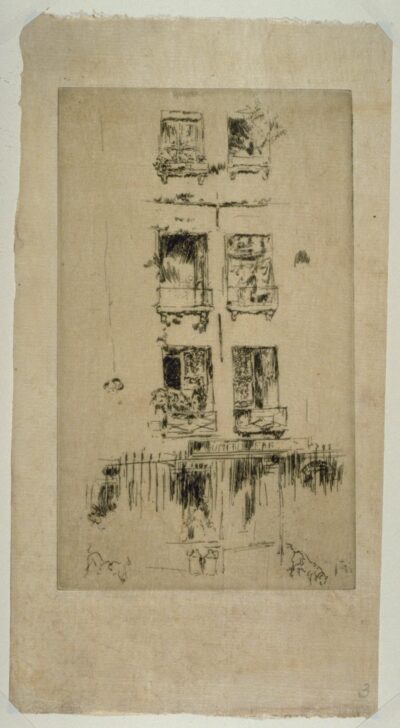Rue de Vannes, Paris
James Abbott McNeill Whistler

Description
Rue Vauvilliers
circa 1892–93
Etching on laid Japan tissue
Only state (Kennedy 439)
Bequest of Margaret Watson Parker, 1954/1.410
Whistler’s commitment to transfer lithography was so thoroughgoing in the 1890s that etchings like this one are extremely rare. Here he returns to the theme of street views, paring the building down to its essential elements in a depiction so minimal that the work borders on pure abstraction; his command at this stage was such that he achieved what he sought in a single state. Near musical in its play of theme and variation, the four-story building becomes an opportunity to juxtapose pairs of windows; the theme varies on each floor, from window boxes on the top floor through a series of balconies on the floors below. Pairs of dogs and milk cans on the street level playfully complete the image on the ground floor where the visual masses of the windows are anchored by the iron fence near the facade. Whistler creates a sense of the wall of the edifice through the placement of his butterfly signature, which is balanced on the right by the abstracted dark knob of a join between two sections of downspout.
These late Paris plates often suffered from negligent care. Whistler carried the prepared plates around wrapped in paper, which abraded the ground; the resultant pitting to the surface meant he had to exert extraordinary control when biting the plate, and rather than submerge it in an acid bath, he used a feather to selectively direct a controlled stream of acid. When Whistler turned to the American artist Frank Short (1857–1945) to print them for him, he directed him to wipe the plates cleanly, eschewing the atmospheric effects contributed by plate tone. He justified this rejection of his characteristic use of plate tone by saying, “what was good enough for Rembrandt is good enough for me.”
Subject Matter:
Whistler focused on lithography over etching during the 1890s, making his etched views of Paris, that were never printed in editions, quite rare.
Whistler uses a partial representation to evoke the whole, playing on the theme and variation offered by the pairs of windows on each floor of the building, as well as for the dogs and cans in the foreground. Another playful touch is the way he employs his "butterfly" signature on the left side to balance the join on the downspout on the right side of the image.
Physical Description:
A partial view of a four-story building, concentrating on pairs of windows on each story and a wrought iron fence on the ground level. Windows have window boxes or balconies; on the ground level are several dogs on either side and a pair of milk cans at the center in front of the fence.
Usage Rights:
If you are interested in using an image for a publication, please visit https://umma.umich.edu/request-image/ for more information and to fill out the online Image Rights and Reproductions Request Form.